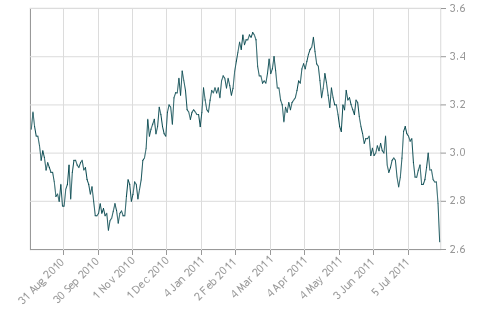The one impact of the US debt ceiling extension has been that government bond yields have dropped significantly over the past week. For instance, the 10-year Canadian government bond benchmark has lost about 25 basis points which is a huge drop:
10-year bond yields are now lower now than they have been since January 2009 (the depths of the financial crisis). The bond markets are highly pessimistic about any form of economic recovery and are trading as such.
Short term rates are no longer pricing in a sure chance of a rate increase – BAX futures are as follows:
| Month / Strike | Bid Price | Ask Price | Settl. Price | Net Change | Vol. |
| + 11 AU | 0.000 | 0.000 | 98.670 | 0.000 | 0 |
| + 11 SE | 98.685 | 98.690 | 98.685 | 0.000 | 23202 |
| + 11 OC | 0.000 | 0.000 | 98.655 | 0.000 | 0 |
| + 11 DE | 98.660 | 98.670 | 98.660 | 0.010 | 42832 |
| + 12 MR | 98.630 | 98.640 | 98.610 | 0.020 | 35992 |
| + 12 JN | 98.590 | 98.610 | 98.560 | 0.040 | 16408 |
| + 12 SE | 98.550 | 98.570 | 98.510 | 0.050 | 7649 |
| + 12 DE | 98.500 | 98.510 | 98.450 | 0.060 | 2729 |
The December BAX Futures are at 98.66 (1.34%) compared to 98.46 (1.54%) when the Bank of Canada made its last pronouncement on short term rates. It no longer appears that short term rates will be rising at all. Three month corporate paper is still at 1.17%. If there is any hint of economic recovery, it is not seen in the bond market.


